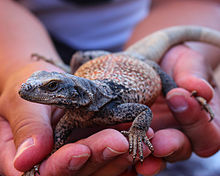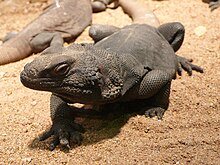Sauromalus
| Chuckwalla Sauromalus |
|
|---|---|
 |
|
| Common chuckwalla, S. ater (male) | |
 |
|
| Common chuckwalla, S. ater (female) | |
| Scientific classification | |
| Kingdom: | Animalia |
| Phylum: | Chordata |
| Class: | Reptilia |
| Order: | Squamata |
| Suborder: | Iguania |
| Family: | Iguanidae |
| Genus: |
Sauromalus Dumeril, 1856 |
| Species | |
|
Sauromalus ater (formerly Sauromalus obesus) |
|
Sauromalus ater (formerly Sauromalus obesus)
Sauromalus australis
Sauromalus hispidus
Sauromalus klauberi
Sauromalus slevini
Sauromalus varius
Chuckwallas are large lizards found primarily in arid regions of the southwestern United States and northern Mexico. Some are found on coastal islands. The five species of chuckwallas are all placed within the genus Sauromalus; they are part of the iguanid family, Iguanidae.
The generic name, Sauromalus, is a combination of two Ancient Greek words:σαῦρος (sauros) meaning "lizard" and ομαλυς (omalus) meaning "flat". The common name "chuckwalla" derives from the Shoshone word tcaxxwal or Cahuilla čaxwal, transcribed by Spaniards as chacahuala.
Chuckwallas are stocky, wide-bodied lizards with flattened midsections and prominent bellies. Their tails are thick, tapering to a blunt tip. Loose folds of skin characterize the neck and sides of their bodies, which are covered in small, coarsely granular scales. The common chuckwalla (Sauromalus ater) measures 15 3/4 inches long, whereas insular species such as the San Esteban chuckwalla of San Esteban Island (Sauromalus varius) can measure as long as 30 in.
They are sexually dimorphic, with males having reddish-pink to orange, yellow, or light gray bodies and black heads, shoulders, and limbs; females and juveniles have bodies with scattered spots or contrasting bands of light and dark in shades of gray or yellow. Males are generally larger than females and possess well-developed femoral pores located on the inner sides of their thighs; these pores produce secretions believed to play a role in marking territory.
...
Wikipedia
